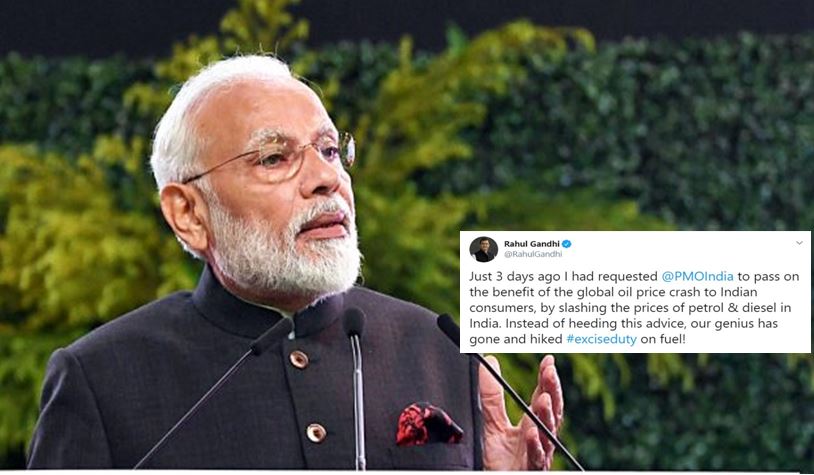A few days ago, the union government increased Central excise duties on petrol and diesel by 3 rupees per litre. This will change the effective price the consumer pays on the petroleum, given the fact that crude oil prices have fallen by more than 40 per cent globally. But the government will earn thousands of crores extra, which will help to contain the burgeoning fiscal deficit.
The consumer was not much concerned will the rise in excise duty by the government but the opposition, led by Rahul Gandhi, tried to create furore over the matter. “Just 3 days ago I had requested @PMOIndia to pass on the benefit of the global oil price crash to Indian consumers, by slashing the prices of petrol & diesel in India. Instead of heeding this advice, our genius has gone and hiked #exciseduty on fuel!” tweeted Rahul Gandhi.
Just 3 days ago I had requested @PMOIndia to pass on the benefit of the global oil price crash to Indian consumers, by slashing the prices of petrol & diesel in India. Instead of heeding this advice, our genius has gone and hiked #exciseduty on fuel! pic.twitter.com/lGEQosS9JE
— Rahul Gandhi (@RahulGandhi) March 15, 2020
The opposition has a right to protest to oppose the government decision but it is important to understand that where the extra money that comes from taxes will be used.
Using the opportunity of the lowest oil prices in almost two decades, the government has decided to fill the strategic oil reserves with cheap Saudi and UAE oil. “It is an opportune time for us and for them (Abu Dhabi National Oil Company and Saudi Aramco) to finalise the deals and fill the SPRs…If there is any delay, we might fill the SPRs on our own,” said an official, as per a report by Business Standard.
The Strategic Petroleum Reserve (SPR) is maintained for any unforeseen emergency. Whenever the supply chain is disrupted or oil prices reach very high, the SPR is used to manage the situation. In a crisis situation like war or some short time escalation too, the SPR can be used.
The countries which are members of the International Energy Agency- an autonomous inter-governmental organization with the majority of western countries as members- has recommended that all countries must have SPR equivalent to 90 days net import. United States has the world’s largest SPR with a total capacity of 727 million barrels. China too has a huge SPR and plans to increase the capacity in the future.
India started building SPRs in mid-2000s and today the country has an existing SPR of 5.3 million tonnes (1tonne =7.33 barrels) at Visakhapatnam (1.33mt), Mangaluru (1.5 mt) and Padur (2.5mt). As the country has the consumption of around 5 million barrels per day-third largest after US at 20 million barrels per day and China at 13.5 million barrels per day, this could support net imports of 10 days.
The Modi government announced the second phase of the ambitious and costly Indian Strategic Petroleum Reserves (ISPR) programme at the cost of 1.6 billion dollars with the aim for additional 12 days reserve of 6.5 mt of SPR at Chandikhol (4 mt) in Odisha and Padur (2.5 mt) in Karnataka. The government floated special purpose vehicle (SPV)—Indian Strategic Petroleum Reserves Ltd. (ISPRL)—-for building these SPRs.
With the additional 12 days capacity, the SPR could supply for net imports of 22 days and given the fact the Oil companies keep storage for 65 days, the total net capacity will reach to net import of 87 days.
With the crude oil prices at a decade low, the government can fill these strategic reserves at very low investment. And the money to buy the SPR will come from the increased excise on petroleum. The low prices are going to help the government in keeping the fiscal deficit in control and build SPR, while the common people will be benefit from the low inflation.
India gets closer to its infrastructure dream, thanks to falling oil prices and low interest rates
Therefore, although opposition has the right to protest because the politics must go on and any opposition party would do the same; the government has taken a wise decision with an increase in taxes for National Interest.
